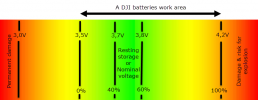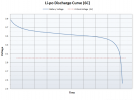Andy carley
Active Member
You tell themThat is a presumption.
In any case let me care about my drone.
You tell themThat is a presumption.
In any case let me care about my drone.
Aside from the risk to the drone, isn't there also a risk to the smart battery when levels get too low? I've had several "new" batteries just die completely and have been told it's because levels get too low and that causes them to completely fail to charge. I know a little off topic here but curious if that's been an issue for others as well.I'm not sure what point you're trying to make.
If your battery level gets down to very low levels, it's programmed to force land, to prevent it from falling out of the sky uncontrollably.
Whether it's connected or not is irrelevant.
If you run the battery level down that far and haven't brought the drone home, that's on you.
Just out of curiosity, if forced landing was disabled, down to what 'percentage' or voltage would you expect the drone to fly?Hi all,
In mini 3 pro there was a parameter in DH to disable forced landing:
bat_enable_smart_bat_landing_protect to 0
Any idea how to disable forced landing in mini 4 pro?
Thanks
Alex
The attached picture below represent a LiPo battery (non high volt (HV))... the redder the color is, the more wear/damage will occur.Aside from the risk to the drone, isn't there also a risk to the smart battery when levels get too low? I've had several "new" batteries just die completely and have been told it's because levels get too low and that causes them to completely fail to charge. I know a little off topic here but curious if that's been an issue for others as well.


Aside from the risk to the drone, isn't there also a risk to the smart battery when levels get too low? I've had several "new" batteries just die completely and have been told it's because levels get too low and that causes them to completely fail to charge. I know a little off topic here but curious if that's been an issue for others as well.
"...very long haul flights ..."The drone is flying over water or in the mountains away from people and I am not asking comments over safety. I am merely asking HOWTO.
This is only used for very long haul flights and not every time. No assumptions please.
I set mine to 18% to signal RTH. That's been fine for me for the past couple years but prior to that I lost several batteries and I'm assuming it was due to storage when low on charge as you mentioned above. Thanks!Depends on what is meant by "low".
You can not damage a DJI battery by simply running the drone to the point it force-lands. When safely back on the ground, the battery will still have more than enough charge to be well above the cell voltages where damage occurs.
However, leaving a battery depleted and then storing it for months can result in dropping to damaging voltage levels through natural self-discharge, damaging one or more cells in the module.
The BMS in a DJI Intelligent Battery will usually detect this, put the pack in a failed state, and refuse to charge.
I think the lowest was 3% and it was due to a strong wind which I did not expect.Just out of curiosity, if forced landing was disabled, down to what 'percentage' or voltage would you expect the drone to fly?
Would you also want the low-voltage drone-switch-off or the low-voltage motor-stop disabled?
I think you said it is possible to disable forced landing for a mini 3 pro, if so where is this documented please?
Well, thanks for your comments, but this is NOT what I was asking."...very long haul flights ..."
With that comment you will attract some very polarised opinions in this thread. Every time someone heads out on a long range jolly, all they're doing is passing a handful of nails to the bodies that write and enforce regulations, so that they can hammer them into everyone else's coffin. Even now the main rules are painfully simple.
1. Don't fly so far away that you can't see your drone.
2. Don't fly higher than 400 feet above what you stand on.
If you want to flip The Man the bird and do your own 'thing', fine. Just don't advertise it on public forums or YouTube.
I never have had issues with the original DJI batteries. On mini 2 once I discharge the battery down to 0% and still was able to return safely.I set mine to 18% to signal RTH. That's been fine for me for the past couple years but prior to that I lost several batteries and I'm assuming it was due to storage when low on charge as you mentioned above. Thanks!
Depends on what is meant by "low".
You can not damage a DJI battery by simply running the drone to the point it force-lands. When safely back on the ground, the battery will still have more than enough charge to be well above the cell voltages where damage occurs.
However, leaving a battery depleted and then storing it for months can result in dropping to damaging voltage levels through natural self-discharge, damaging one or more cells in the module.
The BMS in a DJI Intelligent Battery will usually detect this, put the pack in a failed state, and refuse to charge.
Wrong.Aside from the risk to the drone, isn't there also a risk to the smart battery when levels get too low? I've had several "new" batteries just die completely and have been told it's because levels get too low and that causes them to completely fail to charge. I know a little off topic here but curious if that's been an issue for others as well.
A Lithium battery isn't just "another piece of hardware"... that can be "fixed" if the voltage have been allowed to fall too low.Wrong.
The controller is locking the battery if the voltage dropped below a certain level.
However, it is possible to open the battery and charge it directly a bit and then unlocking the battery controller using CP2112
See this video
DJI is also implementing something into the battery controller "to age" batteries quicker.
We all are going to die at the end you know...
Batteries are not forever either. DJI is also implementing something into the battery controller "to age" batteries quicker.
A Lithium battery isn't just "another piece of hardware"... that can be "fixed" if the voltage have been allowed to fall too low.
Furthermore, the BMS doesn't "lock the battery" in terms of preventing further self discharge & permanent damage... it only deactivate the BMS & by that stop it from draw a small current & prolong the time until the battery gets too damaged.
------------------
A LiPo allowed to fall below 3.0V will sustain permanent damage... the effect of this damage is a increased internal resistance which in turn will generate excessive heat during both charge & discharge. Another even more serious effect is that lithium metal starts to plate out on the anode. This causes dendrite structures to form, which can puncture the separator, causing an internal short-circuit.
If looking at the span between 0V & 3.0V, the amount of damage isn't linear, a battery on 1.0V is far worse than a battery on 2,5V... & one on 0,5V is far worse than one on 1.0V.
Most chargers will not charge LiPo's lower than 2,5V... the reason for this is that, the higher the internal resistance is, the greater the risk is for that the battery goes up in flames due to the heat generated from the higher internal resistance during the charge cycle.
It's possible to bring back a LiPo above 3.0V which only have a couple of mV, this by charging with a very very low current, but it's a very high risk of that the battery catch fire. Trying this out require a hand on the battery the whole time to detect if the battery starts to develop a increased heat build-up which can ignite the battery. BUT this will not in any way revert the damage that the battery sustained by being allowed to fall below 3.0V... the increased internal resistance & the dendrite structures on the anode will remain.
This damaged battery will onward pose a serious threat if you continue to use it...
1. The internal resistance will make that battery very prone to major voltage drops during amp draw, which increases the risk for it to again drop below 3.0V where a DJI drone initiate a forced auto landing.
2. Further more, the extra heat generation most probably soon make the battery swell as the heat will increase the electrolyte decomposition which generates gasses.
3. This battery will continue to be prone to catch fire during use, especially during charging... & from a very high risk of internal short-circuits.
You will never ever be able to trust this battery again...
Do not comment on the subject if you have no idea.No they're not. Stop spreading BS.
Nonsense is your ignorant comment.Nonsense.
We use essential cookies to make this site work, and optional cookies to enhance your experience.


